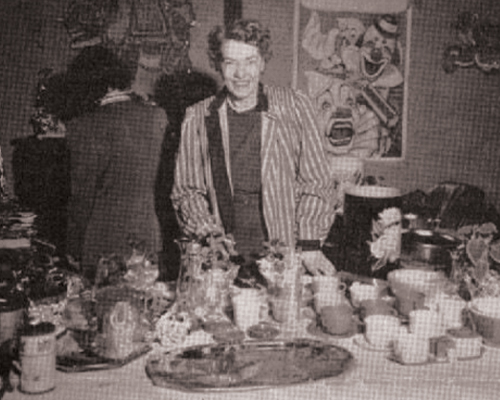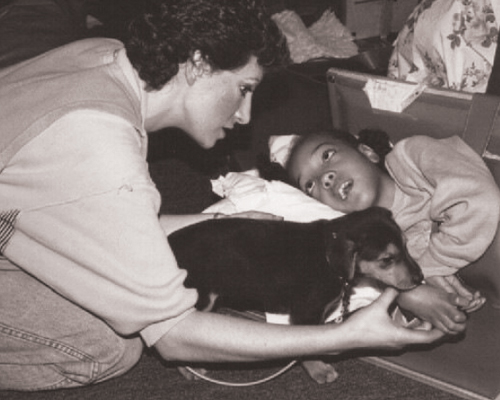The History of Anti-Cruelty Volunteers

The Earliest Volunteers
During its early years, volunteers at Anti-Cruelty played an active role in preventing cruelty on the city’s streets. They reported cruelty to patrolling policemen, displaying a star shaped badge that identified them as an agent of Anti-Cruelty. Police officers were instructed to assist in investigating these cases. During the particularly icy winter of 1919, volunteers crafted carpeted shoes for horses and distributed them to the city’s workhorses to help them gain traction on icy surfaces.
Volunteers were actively involved providing humane education in schools and to community organizations. They established clubs called Bands of Mercy in schools, which played a significant role in fundraising for horse drinking fountains placed throughout the city, including the one in Anti-Cruelty's lobby. Volunteers also conducted Magic Lantern Show presentations as a part of humane education efforts, utilizing Magic Lanterns, an early form of slide projector.

1950s and 1960s
With horses disappearing from Chicago, Anti-Cruelty turned its attention to dogs and cats. With servicemen returning from the war, pets became increasingly more popular with growing families. In 1954, thanks to a generous bequest from Edmund and Emily Hulbert, a shelter annex was built to ease overcrowding.
During the 1960s, media coverage helped to boost adoption rates. Personalities such as Ray Rayner of WGN-TV, Jim Stewart of the “Here’s Geraldine Show”, Lee Phillip of the "Lee Phillip Show," and radio personality John Harrington regularly promoted Anti-Cruelty. Additionally, the Chicago Tribune ran a weekly “pet of the week" feature.
Volunteers continued to support the shelter by organizing benefits. The Annual Rummage Sale and the Holiday Bazaar remained popular events.

1970s and 1980s
In 1973, Chicago Today, an afternoon tabloid, published a scathing exposé of Anti-Cruelty and the Animal Welfare League. They criticized the use of the decompression chamber for euthanasia, deemed it inhumane, and advocated for reducing euthanasia rates. As a result of the exposé, public opinion turned against Anti-Cruelty. Consequently, in 1974, the organization underwent a complete reorganization.
In an effort to enhance transparency and to improve the public’s opinion, Anti-Cruelty launched its first volunteer program open to the public in 1976. Previously, volunteers consisted of either board members or had paid a membership fee. Within the inaugural year, volunteers in the Lost Pet Program reunited hundreds of pets with their owners. Volunteers in the Pet Therapy program visited local hospitals with small companion animals, while volunteer humane educators staffed the traveling SPCA bus. In 1985, volunteers played a critical role in operating the Anti-Cruelty's new Mobile Vaccination Van.

1990 to 2010
In the 1990s, as a response to the recession, the volunteer driven Helping Hands Pet Food Pantry was established. Additionally, in 1995, the first Bark in the Park Event took place. Other Anti-Cruelty initiatives broadened the range of activities available to volunteers.
During the 1990s, the foster program was launched. Volunteers operated the Pet Smart Mobile Adoption Van, which debuted in 1995. Further expanding their involvement, volunteers began caring for animals in the Bruckner Rehabilitation and Treatment Center opened in 2004, as well as the Virginia Butts Burger Clinic and Charlotte's Corner, both of which opened in 2008.
Volunteer programs flourished in the early 2000s as additional opportunities were developed to mobilize community members. This includes the launch of the Cat and Dog Adopts volunteer programs, Post-Surgical Recovery spay/neuter support program, and the weekend Physical Exam veterinary support program.
In 2008, Anti-Cruelty launched the SAFE (Short-Term Accommodation for Emergencies) initiative to provide emergency boarding services for families fleeing domestic violence. Volunteers were a crucial component of the program, providing daily care, socialization, and enrichment for the pets housed onsite through SAFE.
In 2010, volunteer programming at Anti-Cruelty expanded further with the launch of the Dog and Cat Care programs, which provided care and training support to animals before and after adoption hours. These programs ensured staff had the support needed to help thousands of animals entering through the shelter’s doors.

2011 to 2024
In 2011, Anti-Cruelty established new Animal Transport Programs aimed at bringing animals from areas with limited resources to the facility. Volunteers helped the new arrivals at each transport. Volunteers and Fosters provided aid to animals transported from hurricane and flood ravaged regions. Animals were transported from Texas, Florida, Oklahoma and other affected areas.
In 2015, Anti-Cruelty launched expanded initiatives to engage the community through group volunteer programs. Corporate and school groups were invited in to create enrichment items for shelter animals while learning more about Anti-Cruelty's mission through the Crafting Crew program. These volunteer events ensured an abundant supply of toys, bedding, and other enrichment items to improve the quality of life for the animals in Anti-Cruelty's care.
In 2018, volunteers became integral to the launch of two crucial community support programs: Dog Wellness Fairs and Friends Who Care. Both initiatives engaged pet owners across Chicago to provide basic care services and supplies to preserve families and prevent animal surrender.
In 2020, Anti-Cruelty weathered the Pandemic. In early March, Anti-Cruelty launched a request for emergency fosters, which garnered an overwhelming response from nearly 800 volunteers.
In 2021, the Community Care Program was established to serve under-resourced communities in Chicago. Volunteers were key to launching new program initiatives such as Pop-Up Pet Food Pantries and expanding existing programs such as the Dog Wellness Fairs.
As Anti-Cruelty celebrates its 125th Anniversary, it looks to the future of community mobilization through volunteerism on the journey to build a more humane Chicago.
